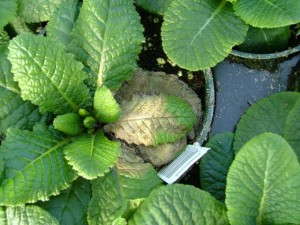Fighting Fall Foliar Disease: The Best Defense Is A Good Offense

Botrytis on primula
There is never a season in our industry where we benefit from long periods of damp, rainy weather. High humidity can impact plants and cause a wide variety of undesirable disease risks. This holds particularly true during poinsettia season. With greenhouses filled to capacity, plants in full bloom and the onset of shorter days, the greenhouse environment can serve as a launch pad for such diseases as Botrytis and powdery mildew. While symptoms of powdery mildew are limited to the leaves and bracts, Botrytis attacks all of the above-ground portions of the plant. Stem cankers and cyathia infections, in particular, can cause significant crop losses.
Managing foliar diseases starts with evaluating the greenhouse environment. Begin by supplying adequate air circulation to reduce the relative humidity in the greenhouse. Allow as much spacing between plants as is economically feasible and avoid promoting disease via leaf condensation. When leaf temperatures are allowed to cool much below the air temperature, the dew point is reached and condensation occurs. Don’t be tempted to open vents on rainy days. If it’s raining or foggy outside, keep the greenhouse closed up and supply heat to lower the relative humidity. Using Horizontal Air Flow (HAF) fans has proven valuable in assisting to control relative humidity.
Properly sized and spaced HAF fans improve the greenhouse environment in several ways. The gentle tumbling action of the air flow breaks up pockets of high-humidity air that form in the plant canopy overnight in the absence of air movement. This reduces the amount of condensation that occurs on plant surfaces and reduces the incidence of foliar diseases. HAF fans also promote more uniform heat distribution throughout the house, contributing to a more uniform crop.
To reiterate, cultural practices that reduce foliar infections include good air circulation, timely and proper plant spacing and managing relative humidity. Overcrowding, low light intensities and shading caused by overhead hanging baskets favor development of these diseases. Avoid rapid temperature changes that may increase relative humidity. Even with the best cultural controls, fungicides are still needed. Examples of effective fungicide sprays for Botrytis include Affirm, Cease, Medallion, Pageant Intrinsic and Palladium. Spray options for powdery mildew include Cease, Eagle and Pageant Intrinsic. These products may not be registered for use in all states; be sure to consult your supplier for details.
Source: GGSPro Tech Tips (used with permission)









